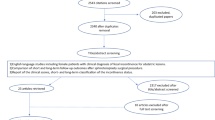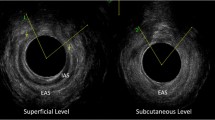Abstract
Purpose
The surgical treatment of chronic anal fissure is basically done by therapeutic controlled damage to the internal anal sphincter. While fecal incontinence is a well-documented early complication of anal fissure surgery, few data are available about delayed incontinence. The aim of the present study was to assess whether surgical treatment of anal fissures may contribute to the development of delayed anal incontinence.
Methods
A retrospective review of patients referred to the Pelvic Floor Laboratory for physiological evaluation of anal incontinence between 1992 and 2009. All patients, diagnosed with anal fissures, who underwent anal dilatation or partial lateral internal sphincterotomy and developed incontinence at least 4 years after the surgery were included. Controls were patients with delayed anal incontinence after obstetric injury.
Results
A total of 21 patients with delayed post-anal fissure surgery incontinence (nine women and 12 men) were identified. The mean (SE) age of incontinence onset in this group of patients was 51.5 (±2), which was 8 years younger than the rest of the 363 incontinent patients (p < 0.001). Time from presumed anal sphincter damage to the onset of incontinence was significantly shorter in the group of past anal-fissure-surgery patients compared to post-obstetric trauma patients (mean difference 15 years, p < 0.001). The severity of incontinence was higher in post-obstetric trauma patients.
Conclusions
Fecal incontinence may present as a late complication of anal fissure surgery. Incontinence may be associated with other cofactors accumulating over time or, more likely, anal fissure surgery may accelerate the physiologic age-related weakening of the anal sphincter mechanism. Candidates for anal fissure surgery should be informed regarding this possible outcome.



Similar content being viewed by others
References
Wald A (2007) Clinical practice. Fecal incontinence in adults. N Engl J Med 356:1648–1655
Konsten J, Baeten CG (2000) Hemorrhoidectomy vs. Lord’s method: 17-year follow-up of a prospective, randomized trial. Dis Colon Rectum 43:503–506
Nygaard IE, Rao SS, Dawson JD (1997) Anal incontinence after anal sphincter disruption: a 30-year retrospective cohort study. Obstet Gynecol 89:896–901
Lysy J, Israeli E, Levy S, Rozentzweig G, Strauss-Liviatan N, Goldin E (2006) Long-term results of “chemical sphincterotomy” for chronic anal fissure: a prospective study. Dis Colon Rectum 49:858–864
Lysy J, Israelit-Yatzkan Y, Sestiery-Ittah M, Weksler-Zangen S, Keret D, Goldin E (2001) Topical nitrates potentiate the effect of botulinum toxin in the treatment of patients with refractory anal fissure. Gut 48:221–224
Isbister WH, Prasad J (1995) Fissure in ano. Aust N Z J Surg 65:107–108
Magee HR, Thompson HR (1966) Internal anal sphincterotomy as an out-patient operation. Gut 7:190–193
Nyam DC, Pemberton JH (1999) Long-term results of lateral internal sphincterotomy for chronic anal fissure with particular reference to incidence of fecal incontinence. Dis Colon Rectum 42:1306–1310
Jensen SL, Lund F, Nielsen OV, Tange G (1984) Lateral subcutaneous sphincterotomy versus anal dilatation in the treatment of fissure in ano in outpatients: a prospective randomised study. Br Med J (Clin Res Ed) 289:528–530
Talley NJ, O’Keefe EA, Zinsmeister AR, Melton LJ 3rd (1992) Prevalence of gastrointestinal symptoms in the elderly: a population-based study. Gastroenterology 102:895–901
Camilleri M, Cowen T, Koch TR (2008) Enteric neurodegeneration in ageing. Neurogastroenterol Motil 20:185–196
Bump RC, Norton PA (1998) Epidemiology and natural history of pelvic floor dysfunction. Obstet Gynecol Clin North Am 25:723–746
Pernikoff BJ, Eisenstat TE, Rubin RJ, Oliver GC, Salvati EP (1994) Reappraisal of partial lateral internal sphincterotomy. Dis Colon Rectum 37:1291–1295
Chowcat NL, Araujo JG, Boulos PB (1986) Internal sphincterotomy for chronic anal fissure: long term effects on anal pressure. Br J Surg 73:915–916
Sharp FR (1996) Patient selection and treatment modalities for chronic anal fissure. Am J Surg 171:512–515
Lysy J, Sistiery-Ittah M, Israelit Y et al (2003) Topical capsaicin–a novel and effective treatment for idiopathic intractable pruritus ani: a randomised, placebo controlled, crossover study. Gut 52:1323–1326
Author information
Authors and Affiliations
Corresponding author
Rights and permissions
About this article
Cite this article
Levin, A., Cohen, M.J., Mindrul, V. et al. Delayed fecal incontinence following surgery for anal fissure. Int J Colorectal Dis 26, 1595–1599 (2011). https://doi.org/10.1007/s00384-011-1284-7
Accepted:
Published:
Issue Date:
DOI: https://doi.org/10.1007/s00384-011-1284-7




